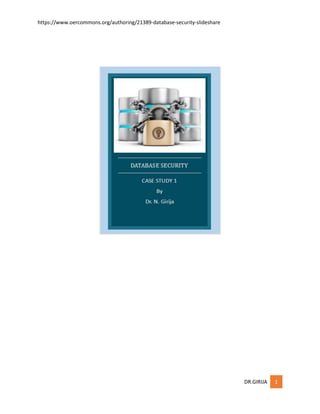OER -CASE STUDY 1-DB SECURITY
- 2. https://www.oercommons.org/authoring/21389-database-security-slideshare DR.GIRIJA 2 CASE STUDY -1 This case study covering three units such as unit 1 authentication, unit 2 User profile and Unit 3 Authorization. In this case study below given Account and Purchase tableŌĆÖs information are used. In the ŌĆ£HRŌĆØ schema create and insert values of Account and Purchase table. The user Meara profile ŌĆ£meeralimitŌĆØ has following limits, the user can reuse the password after 15 days, the user allow to try two incorrect password, suppose both the attempts she fail to give correct password then it never open the account automatically. The password is valid only 45 days. The password function ŌĆ£checkpwdŌĆØ which will restrict the meeralimit profile has at least has one character and one digit and one punctuation. Test the checkpwd is implemented in the user Meera for changing password as ŌĆ£meeraŌĆØ, if it is error then change password as ŌĆ£meera$456ŌĆØ. Display the resource name, limits of profile meeralimit. Create default permanent tablespace as ŌĆ£meera_tsŌĆØ with quota 500k to Meera. Create two role as salaried_customer and another one is Normal_customer. Assign salaried_customer role to Meera by default. The salaried_customer has select privileges of purchase table. Raju has Normal_customer type. Create synonym for purchase table as ŌĆ£pursynŌĆØ. Assign select privilege of pursyn to Raju. Display pucharase_no, amount column of pursyn.
- 3. https://www.oercommons.org/authoring/21389-database-security-slideshare DR.GIRIJA 3 Account Table Account_no uname Min_balance 123 Meera 100 456 Anand 100 789 Raju 250 Create table account (account_no number (6) primary key, uname varchar2 (15), min_balance number (5)); Insert into account values (123,ŌĆÖmeeraŌĆÖ, 100); Insert into account values (456,ŌĆÖanandŌĆÖ, 100); Insert into account values (789,ŌĆÖrajuŌĆÖ, 250); Purchase Table Purchase_no amount Customer_type Account_no 1 300 Salaried_customer 456 2 400 Salaried_customer 456 3 380 Normal_customer 789 4 450 Salaried_customer 123 5 250 Normal_customer 789 Create table purchase (pno number (5) primary key, amount number (5), ctype varchar2 (20), account_no number (6) references account (account_no)); Insert into purchase values (1, 300,ŌĆÖsalaried_customerŌĆÖ, 456); Insert into purchase values (2, 400,ŌĆÖsalaried_customerŌĆÖ,456); Insert into purchase values (3, 380,ŌĆÖNormal_customerŌĆÖ, 789); Insert into purchase values (4, 450,ŌĆÖsalaried_customerŌĆÖ, 123); Insert into purchase values (5, 250,ŌĆÖNormal_customerŌĆÖ, 789);



